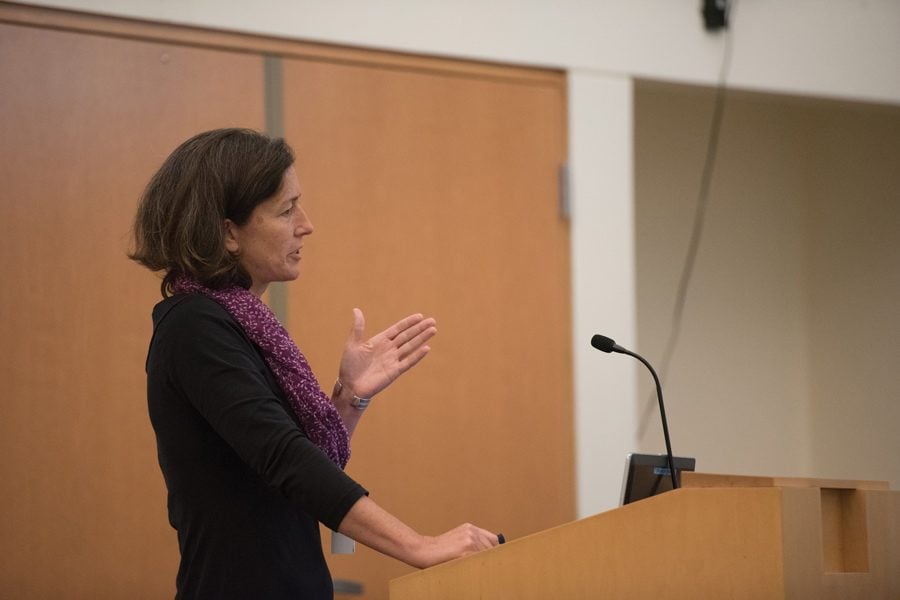School board considers expansion of Two-Way Immersion program
(Oreste Visentini/The Daily Northwestern)
Stacy Beardsley, Evanston/Skokie School District 65’s associate superintendent of curriculum and instruction, speaks at a board meeting Monday. Board members discussed expanding the Two-Way Immersion program.
October 10, 2017
Evanston/Skokie School District 65 board members debated how to implement new classes for the district’s Two-Way Immersion program, a curriculum in which native English and Spanish speakers attend class together to increase cultural competence.
The program — popular among parents but difficult to execute — also aims to increase academic achievement and bilingualism, said Stacy Beardsley, District 65’s associate superintendent of curriculum and instruction.
Five of the district’s elementary schools — Dawes, Dewey, Oakton, Washington and Willard — have implemented TWI programs since 2001. Although school board members discussed the creation of two more TWI programs by fall 2018, they said the decision would be complicated.
“This is something that is going to be good for our district, but there will be some growing pains,” board president Suni Kartha said.
Beardsley agreed and emphasized the issue of division between TWI classes and monolingual classes. She said the best solution would be implementing the two new TWI programs in a way that creates an environment centered on bilingualism. For example, the district could put the new programs at one school or split them between schools with existing TWI classes, Beardsley said.
However, she also said the TWI classes would have to replace English-only classes due to the lack of space and resources.
Board members said TWI fits into the district’s emphasis on equity, but underrepresentation in the program among black students is still an issue.
Board vice president Anya Tanyavutti said while survey results show black parents were interested in the program, less than half of those interviewed this year knew about TWI.
“There is a history of black families being left out of a program,” Tanyavutti said. “(Including them) in an intentional way is really important.”
Kartha and Beardsley said they do not yet have a definitive solution for including more black students in the program.
Beardsley said the proportion of Spanish-speaking and English-speaking students is not split evenly in TWI classes, but research shows it should be.
Despite increasing demand for the program across the board, Spanish-speaking students are given precedence in enrollment to prioritize the needs of English language learners, Beardsley said. Only 42 percent of English-speaking students were accepted into the program last year.
During the 2016-17 school year, 65 percent of students in the program were native Spanish speakers, and 35 percent were English-speaking students. Because this proportion deviates from the TWI model — which recommends that a class is evenly split — the program could end if it isn’t balanced throughout the expansion, Beardsley said.
“With all the change, we have to look at what are the pros and cons and find the best possible pathway,” Beardsley said. “In the short term, there will be drawbacks. But in the long term, schools should and could and would come to embrace diversity as a value.”
Kartha said the school board will continue to discuss TWI expansion plans at its Nov. 6 meeting, when the board plans to recommend a location for the two proposed programs.
Following the November meeting, Kartha said, board members will begin community outreach and prepare a student application by January.
“If we have a strong sense of school community responsibility, it’s something where we have an opportunity to embrace TWI,” Beardsley said.
Email: [email protected]
Twitter: @caity_henderson


